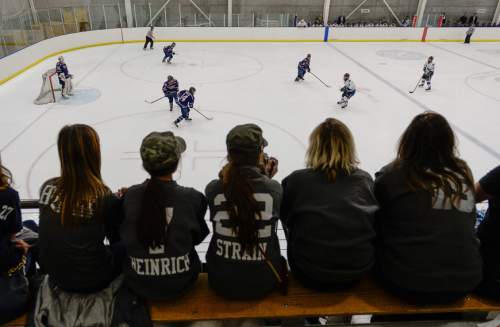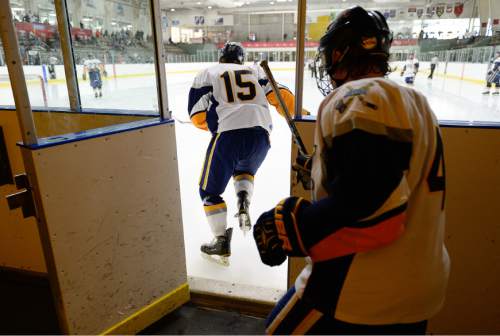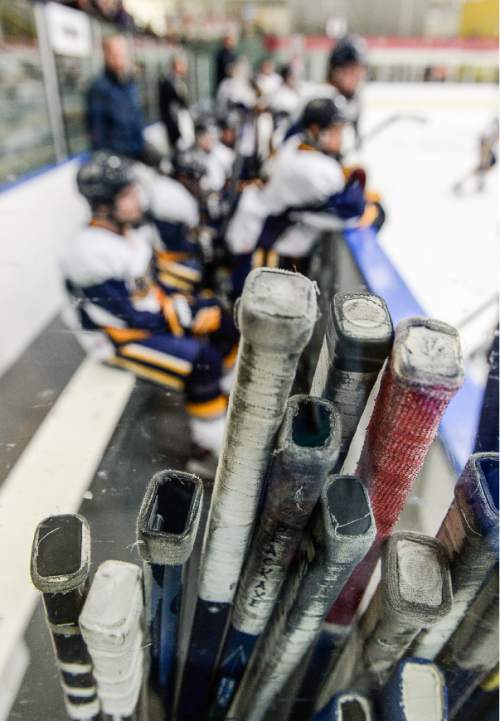This is an archived article that was published on sltrib.com in 2015, and information in the article may be outdated. It is provided only for personal research purposes and may not be reprinted.
There's the pervading smell of cold sweat soaked through synthetic leather and plastic foam pads — briefly masked at times by a generous application of deodorant. There are sounds of sticks and skates assaulting the ice amid endless shouts of "Let's go, boys" in both Northern and affected Northern accents.
And, yes, there are mullets.
It's everything hockey is supposed to be, to the fourth power, at the Salt Lake City Sports Complex. Culled from 190, the top 16 teams in the American Collegiate Hockey Association's Division II — each featuring 22 players and an untold multiplier of family, friends and support staff — are calling Salt Lake City home for the five-day tournament.
Some of the clubs, like Utah's Skatin' Utes, have scraped together every cent they have to field a team. Others are club in name only: Division II commissioner Mike Radakovich said the budget at one school exceeds $100,000.
"Schools have discovered that there are actually players who will go to a school to play club hockey," Radakovich said.
NYU is one such school. Players buy their equipment, but the university picks up the tab for everything else. The decision of sophomore forward David Morgan to attend NYU, estimates his dad, Glyn, was 50 percent for the excellence of the business school and 50 percent for the excellence of the club hockey team.
"His dream was to play for this team," said Glyn, sitting Friday with a few dozen other violet-clad fans who made the 2,000-mile trip to show support.
Among them was student manager Angie Gokhman, an NYU graduate psychology student who used an iPad to track shots, saves, face-offs, goals and plus/minus while NYU beat Northern Arizona 3-1. When Gokhman sees the parents and friends of the team, she explained, "it's almost like seeing family."
Over at the skate sharpener, in the bowels of the complex, a teammate handed his skates to William Paterson senior James Henry and asked for a three-eighths cut, settling instead on a half-inch cut at Henry's recommendation.
William Paterson, like NYU, is a club powerhouse, but the New Jersey school's allure for Henry was its renowned jazz program. Asked how he got the honor of sharpening skates, the Edmonton native said without a hint of indignation that he was a healthy scratch for the game against Boise State: "We've got a deep team, and I'm not one of the good ones, I guess."
Meanwhile, at the east rink, a noticeably tan bunch from Florida Gulf Coast — last year's runners-up — gathered to dress their sticks and commentate on a 4-3 overtime thriller between Grand Valley State and Liberty.
Behind them, propped against the wall in the hallway between locker rooms, manager Kate Wyatt read "How Paris Became Paris: The Invention of the Modern City" to kill time before her team's game. Wyatt began helping the team to earn volunteer hours; now working in an attorney's office, she stuck on after graduation. This — feeding her team's voracious appetite for Gatorade, stick tape and the like — is her vacation.
"Without Kate, the team wouldn't function," informed a player while she smiled bashfully.
Twenty yards north of Wyatt, Utah graduate student athletic trainer Jaclyn Arduini kept an eye toward the ice for injuries. Most commonly, she said, she treats shoulder injuries, or overuse injuries to backs, hips and knees. Thankfully, she agreed, they are made to wear facemasks.
The players aren't the only ones who might require Arduini's attention. Philadelphia-based referee Kevin George skated over to the Gatorade cooler when the first period horn sounded, huffing and remarking with a smile, "These kids are a lot faster than when I was playing."
George, a culture buff, said he was excited to use downtime between games for a second visit to Temple Square on Sunday.
Down at the southeast exit, NAU players filed out in suits — for whatever reason, club hockey players tend to travel in suits — and in silence. Said head coach Travis Johanson before boarding the bus that had taken them 519 miles north, "road trips are always fun, but they're better when you're winning."
A little later, some idle Lindenwood players occupied themselves trying to guess the flags that hang above the benches of the east rink, getting stuck on what The Tribune will later learn is Liechtenstein's.
Of course, hockey was played, too. Following an inspired speech at the entrance to the ice surface that consisted mostly of one player repeating "[Expletive] yeah," and smiling widely, Florida Gulf Coast beat Northeastern 5-3 on three third-period goals. Upstairs, while Gary Glitter's "Rock and Roll Part II" played on the loudspeakers, the parents of Northeastern's players hung their heads and left without a word.
The Skatin' Utes enjoyed a solid home-ice advantage on their way to a 4-2 pool victory over Missouri State, though president and general manager A.J. Boldan said the attendance paled in comparison to this year's inaugural Wasatch Cup, when it was standing-room only.
Boldan estimates that the Utes regularly draw about 500. When the program rebooted in 2006, "We had 20 guys, so, a parent for each guy. And maybe some girlfriends."
Unlike NYU or William Paterson, Utah receives only a small portion of its funding from the school, capped by student government at $5,000. Each player pays $2,800, Boldan said.
Boldan notes that contrary to the reputation of some club sport affiliations, ACHA mandates that athletes must also be enrolled as students — at least nine credit hours for an undergrad, and six for a graduate student — and that Utah's team GPA is 3.2.
Asked if Utah could someday go the way of Arizona State — which fielded two club teams, at Division I and Division II, and recently announced that its top-tier team will be elevated to the NCAA Division I level — Boldan said "there's always hope."
"I think what a lot of athletic directors are realizing is that hockey is a revenue-positive sport."
In the meantime, Utah will try to climb the ranks at the club level. In similar shoes, Boise State assistant coach Kory Scoran said it's important for regionally isolated clubs like his to join the ACHA's elite, so that other teams have incentive to visit.
Powerhouses like Florida Gulf Coast, for instance, rarely need to travel. Teams from Boston University, Liberty, Eastern Michigan, Northeastern, UMass Lowell, Central Michigan, Illinois State, Michigan State, Michigan and UMass Amherst all made the trip to Fort Myers, Fla., this year, while the Eagles traveled to Virginia twice.
Of course, Fort Myers has something else going for it, and look no further than the helmet of goalkeeper Mike Reed for that something.
Painted over Reed's facemask are a pair of sunglasses. Down the sides, palm trees.
[Expletive] yeah, indeed.
Twitter: @matthew_piper —
ACHA Division II National Championships
Where • Salt Lake City Sports Complex
Sunday • Eight pool games, starting at 10:30 a.m. and ending with an 8:30 p.m. start. Utes drop the puck against Northeastern at 7:30 p.m.
Monday • Two semifinals at 5 and 8 p.m.
Tuesday • Championship game at 7 p.m.
Cost • $10 per game, $15 for championship game, $65 for tournament pass. Children 12 and under are admitted at no cost.
Watch from home • Video and unofficial stats at universityofutahhockey.com/multimedia/broadcasts/



























